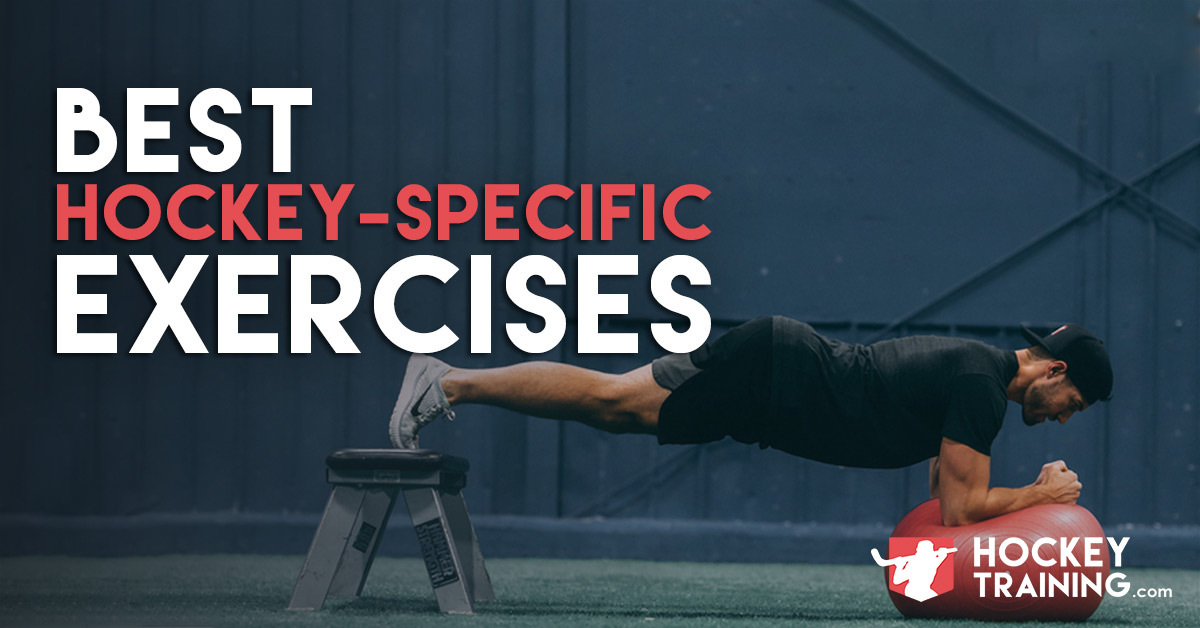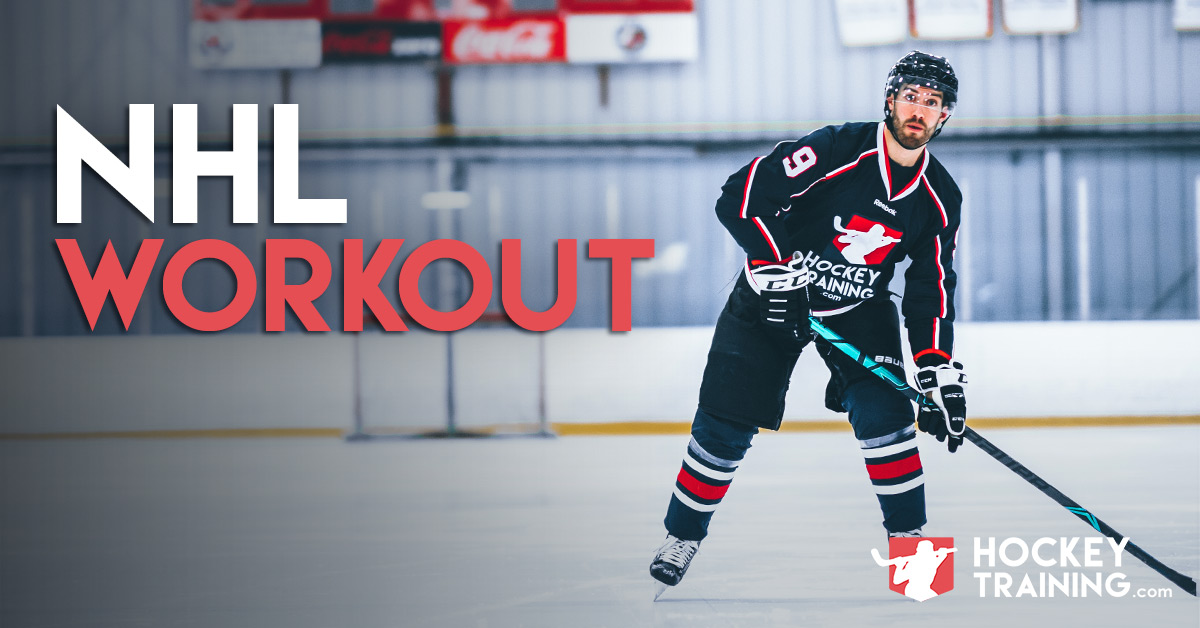In today’s article I wanted to provide you with some of the best training exercises for hockey players.
I have been repeating for many years on end now the phrase that should be beaten into the head of all my readers:
Just because you’re training, doesn’t mean you’re training for hockey.
Too many athletes run very general programs such as bodybuilding routines, powerlifting routines, and CrossFit — and sometimes they just sort of make things up as they go along and hope that it turns out to improve their performance in the end.
This isn’t how sports science works and it’s definitely not how program design works if it were that easy then there would be no “best strength and conditioning coaches” out there because everyone would be doing the same things.
Creating a workout and full program design for hockey performance takes extreme attention to detail surrounding the principles of training and what types of methods as best suited to create a transfer-effect of what you’re doing in the gym and how that represents itself to an improvement on the ice.
Put another way;
A collection of workouts doesn’t mean that it’s a real hockey program…
A collection of exercises doesn’t mean that it’s a real hockey workout…
And a collection of reps doesn’t mean that it’s a set that will have anything to do with performance enhancement out on the ice.
There is a principle in training known as the principle of specificity which I outlined quite thoroughly in this blog — but it simply states that what you are doing in the gym must in some way be specific to the outcome you want in the end.
Low specificity exercises for hockey could be BOSU ball squats, DB concentration curls, and cable crossovers because they will play almost no role in the outcome of your performance come game day.
Whereas high specificity exercises are the ones that hockey athletes should generally have in their program design in some form or another year-round.
The volume, intensity, and frequency of these exercises would change depending on the goal of the training phase (pre-season, in-season, post-season, off-season, etc.), but in general, these are your best hockey training exercises in the book.
Let’s talk about each one and not just go through the “how” of their execution, but the “why” behind their implementation as well.
#1 – Bulgarian Split Squats
Bulgarian split squats are arguably the most well-rounded exercise in the hockey training world.
Due to the biomechanics of skating hockey athletes develop tightnesses in their hips, groin, calves, ankles, and hamstrings — Bulgarian split squat help alleviate all of these issues.
Beyond this, the articulation of the ankle pointing the toes slightly outwards during the skating motion causes hockey players to have overdeveloped vastus lateralis muscles (the thick meaty outer portion of your thigh) and underdeveloped vastus medialis oblique muscles (the teardrop looking muscle on your inner-knee area).
Again, the Bulgarian split squat helps alleviate all those issues as well.
Moreover, it is also a unilateral exercise which means that it corrects for strength differences between your legs as well, making you a more structurally balanced athlete who’s much less prone to injury.
When you have a lower body exercise that checks all these hockey-specific boxes for performance and also packs on muscle and strength at the same time, you have yourself a real winner.
That being said, if you have pain doing this movement or you don’t have the mobility to properly do it, here’s the progression you would want to go through.
Bulgarian Split Squat Progression
Weeks 1-3: Front Foot Elevated DB Split Squats
Weeks 4-6: Standard DB Split Squats
Weeks 7-9: DB Bulgarian Split Squats
Using this progression, you will build the necessary strength and mobility required to eventually be able to safely perform the Bulgarian split squat – and therefore get the benefits of this superstar in the hockey training world.
#2 – Pull-Up and Chin-Up Variations
Although hockey athletes like to place a massive emphasis on things such as speed, your speed won’t matter much if your shot is terrible.
Exercises need to be in place so you can have a deadly shot to match your deadly speed.
In order to accomplish this, we need strong grip strength along with a strong and powerful set of back muscles.
Because of the many different muscle groups in the back, your workouts need to include an even distribution of both vertical and horizontal pulling exercises as these are all going to play into your shot power.
Some of the best vertical pulling exercises include all variations of pull-ups, all variations of chin-ups, and all variations lat pulldowns.
Whereas the best horizontal pulling exercises include BB row, Pendlay row, Rope face pulls, one arm or two arm DB rows, seated cable row variations, and the chest supported row machine.
Additionally, due to the wide range in fiber distribution, it is wise to incorporate a range of 6-20 within your programming.
This is not to mean your rep range for all workouts should be 6-20, I mean this is the range that is best to work within throughout the year.
For example, for one phase your rep range may be 6-8, but the next could be 18-20.
Just don’t escape the high or low-end recommendations in most cases.
Although I am briefly discussing all of your back work here, my favorite exercises in this category to improve shot power is without a doubt the various pull-up and chin-up options.
I just find they perform so much better than the cable/pulldown versions of these exercises.
Pull-ups and chin-ups check so many boxes:
- Grip strength
- Core strength
- Posterior chain development
- Emphasis on lat development
These are all prime drivers for a brutally hard shot, beyond this, performing pull-ups and chin-ups in your programming year-round goes a long way towards preventing the common shoulder injuries hockey athletes run into.
My favorite exercises here are:
Wide Pronated Grip Pull-Ups
Close Grip Pronated Pull-Ups
Supinated Grip Chin-Ups
#3 – Sprint Variations
Utilizing many different sprint variations within your speed and conditioning programming is something that is going to have a direct transfer over to the ice when incorporated properly.
I want you to think outside the box here as well, I utilize over a dozen different sprint variations in the speed and conditioning programming here at HockeyTraining.com.
All of these examples (and many more) in combination with the fact that sprints allow you to train the exact anaerobic energy systems you will be using out on the ice for your sport-specific speed and conditioning make it a must for any logical hockey training program.
If this wasn’t enough, utilizing sprint in the offseason as opposed to just always hammering away on laterally based skating movements will pay large dividends towards keeping you structurally balanced and reducing your injury risk.
Remember what I said earlier about hockey athletes having an undeveloped VMO due to the in-season?
This is a direct cause of too much skating and not enough smart programming to keep us safe.
Knowing this, hockey players need to have a heavy focus in the off-season on developing the VMO with the time that they have before they are back into playing again.
Developing this muscle is going to create a more balanced musculature which will convert itself into a greater ability to be faster and prevent injury.
Sprinting helps this process along as it is not a lateral movement.
When thinking movement mechanics and imagining what I’m talking about here, picture where your toes are when you’re skating forward.
They point out slightly to the side as you press your blades into the ice and explode from there, this “toes pointed out” motion is what is creating the imbalance within the quadriceps.
Sprinting, on the other hand, your toes are much more forward – I don’t know anybody who runs like they skate.
Except for ducks I guess, they do that.
When running, the toes are pointing forward which recruits much more medialis and hamstring into the movement while still not totally neglecting the lateralis (which is what becomes over-developed and dominant if all you do is repeat the lateral motion all the time).
The difference in muscle recruitment pattern in combination with the sprints force production capabilities is giving us a lot of reasons to start sprinting immediately if you aren’t already.
When you increase a hockey athlete’s ability to create force in locomotion, it will enable him to transfer it into a greater stride length.
Sprinting is one of the most explosive things an athlete can do and when you increase their sprinting speed, you will also be increasing their skating speed. Period.
Some of the best sprint variations that hockey athletes can do are:
Falling Start Sprint
Backpedal Sprint
Horizontal Crossover Sprint
Horizontal Single-Leg Start Sprint
Mountain Climber Sprint
Final Thoughts
Although there are many other exercises in the strength and conditioning world that benefit hockey athletes, these three exercises check the most boxes for speed, conditioning, structural balance, injury prevention, having a harder shot, and becoming more agile out on the ice.
In some form or another, variations of these movements should be in your programming year-round in order to support optimal hockey performance.
But like I said previously, a program is much more than just a collection of exercises, so if you would like a massive collection of “done for you” hockey training programs then head on over to the Hockey Skills Accelerator and get hooked up today so you can become a better hockey player!










I am 66 years old. I played minor pro hockey. 6 foot 1 inch tall 185
I am active but do not work out. I am playing hockey once per week but intend to increase my playing next year after I retire.
In my last 2 years I have lost the jump/strength in my legs and my upper body muscle mass has deteriorated
I want to start a regimen to get some strength back to my legs and upper body for my hockey and golf games to benefit.
Where should I start.
Hey Jim!
Glad to hear you’ll be retiring soon and that you’ve got more time on your hands for hockey, that’s awesome.
I think you should slowly ease your way back into working out as it’s going to help you feel a lot better out on the ice.
If I were you, I would do 2 weeks of just mobility work to prepare the body for more movement — 3 to 4 sessions per week using these routines from our YouTube playlist: https://www.youtube.com/watch?v=U1EX7tUj2aA&list=PLJz7vgDj_Tre7zajKJTRV05CO2ocSnnq7
Once you’ve got that done, do some at-home bodyweight-only training for another 2-4 weeks to strengthen up the joints and muscles again, 2-3 sessions per week rotating through workouts you can find from this YouTube playlist: https://www.youtube.com/watch?v=icMkVs2-vbI&list=PLJz7vgDj_TrdIxA3BDoTD7LIUbLx1FKDN
Once you have got all of that under your belt, I would recommend getting on either the Weekend Warrior or Men’s League Domination 3.0 system we have here: http://www.hockeytraining.com/programs
Hope this helps!